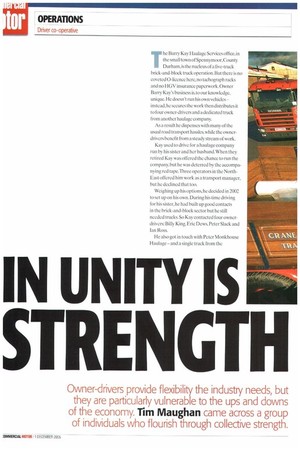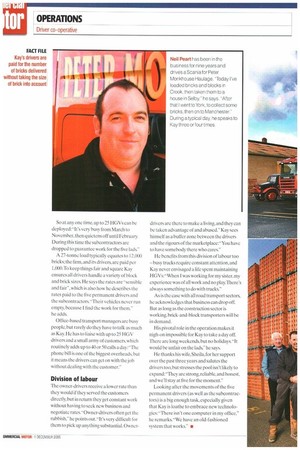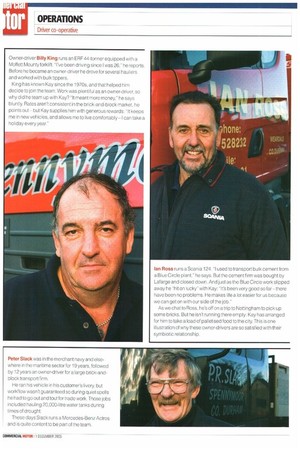14 UNITY IS
Page 50

Page 51

Page 52

Page 53

Page 54

If you've noticed an error in this article please click here to report it so we can fix it.
STRENGTH
Owner-drivers provide flexibility the industry needs, but they are particularly vulnerable to the ups and downs of the economy. Tim Maughan came across a group of individuals who flourish through collective strength.
The Barry Kay Haulage Services office, in the small town of Spennymoor, County Durham, is the nucleus of a five-truck brick-and-block truck operation. But there is no coveted 0-licent.e here, no tachograph racks and no HG V insurance paperwork.Owner Barry Kay's business is. to our knowledge, unique. He doesn't run his own vehicles — instead. he secures the work then distributes it to four owner-drivers and a dedicated truck from another haulage company.
As a result. he dispenses with many of the usual road transport hassles, while the ownerdrivers benefit from a steady stream of work.
Kay used to drive for a haulage company run by his sister and her husband. When they retired Kay was offered the chance to run the company, hut he was deterred by the accompanying red tapc.Three operators in the NorthEast offered him work as a transport manager, but he declined that too.
Weighing up his options, he decided in 2002 to set up on his own. During his time driving for his sister, he had built up good contacts in the brick-and-block sector hut he still needed trucks. So Kay contacted four ownerdrivers: Billy King, Eric Dews, Peter Slack and Ian Ross.
He also got in touch with Peter Monkhouse Haulage — and a single truck from the
Monkhouse Ileet.driven by Neil Peart. completes the group.
"I knew them all, apart from Neil Peart." Kay explains.I approached them:we met in a restaurant and sorted it all out."
Inevitably, joining Barry Kay Haulage Services was something of a risk because the owner-drivers had each carved out their own businesses, and earned valuable goodwill from their customers.
But the gamble was justified because all five trucks are busy. Approximately 90% of their work involves serving builders merchants, while the remaining 10%, as Kay says, is-extra haulage": delivering to small, private customers, and to large transport companies that service the construction sector.
Operators are generally. kept busy buying
fuel, arranging the holiday rota and making provision for sick pay. Kay readily admits he didn't want to take on these burdens.
Never running empty When CM ■I•lis him on an overcast Monday morn ing, our conversation is punctuated by drivers' calls—and they're all busy. "Billy is loading at Bishop Auckland, then he's off to Beverley in East Yorkshire. Erie's going to Oldham and Neil's going to Stoke-on-Trent. Peter's in Bedfordshire and Ian's doing two drops, in Sheffield and Derby. We go all over. The only place we don't go is Scotland, because there are no return loads.
The five lads are with me all the time, hut I also run up to 15 subcontractors, who venture to the South Coast."
So at any one time, up to 25 HGVs can he deployed:"It's very busy from March to November, then quietens off until February. During this time the subcontractors are dropped to guarantee work for the five lads."
A 27-tonne load typically equates to 12.000 bricks; the firm.and its drivers, are paid per 1.000. To keep things fair and square Kay ensures all drivers handle a variety of block and brick sizes. He says the rates are -sensible and fair", which is also how he describes the rates paid to the live permanent drivers and the subcontractors, 'Their vehicles never run empty, because I find the work for them," he adds.
Office-based transport managers are busy people. but rarely do they have to talk as much as Kay He has to liaise with up to 25 HG' drivers and a small army of customers, which routinely adds up to 40 or 50 calls a day: "The phone bill is one of the biggest overheads, but it means the drivers can get on with the job without dealing with the customer."
Division of labour
The owner-drivers receive a lower rate than they would if they served the customers directly, hut in return they get constant work without having to seek new business and negotiate rates."Owner-drivers often get the rubbish.' he points out."It's very difficult for them to pick up anything substantial. Owner drivers are there to make a living. and they can be taken advantage of and abused." Kay sees himself as a buffer zone between the drivers and the rigours of the marketplace:"You have to have somebody there who cares."
He benefits from this division of labour too — busy trucks require constant attention, and Kay never envisaged a life spent maintaining FICIVs:"When I was working for my sister, my experience was of all work and no play.There's always something to do with trucks."
As is the case with all road transport sectors, he acknowledges that business can drop off. But as long as the construction sector is working, brick-and-block transporters will be in demand.
His pivotal role in the operation makes it nigh-on impossible for Kay to take a day off. There are long weekends, but no holidays. "It would be unfair on the lads," he says.
He thanks his wife,Sheila, for her support over the past three years and salutes the drivers too, but stresses the pool isn't likely to expand:"They are strong.reliable.and honest, and we'll stay at five for the moment."
Looking after the movements of the five permanent drivers (as well as the subcontractors) is a big enough task, especially given that Kay is loathe to embrace new technologies:"There isn't one computer in my office." he remarks. "We have an old-fashioned system that works." el Neil Peart has been in thE business for nine years and drives a Scania for Peter Monkhouse Haulage. "Today I've loaded bricks and blocks in Crook, then taken them to a house in Selby" he says. "After that I went to York, to collect some bricks, then on to Manchester." During a typical day, he speaks to Kay three or four times.
FACT FILE Kays drivers are paid for the number of bricks delivered without taking the size of bnck into account
Eric Dews operates a six-wheel Foden wagon and drag with an Atlas crane. "I've been an owner-driver for 22 years," he says. Before he joined the Kay stable, Dews was busy shifting bricks and blocks for a large operator so, once again, why team up with Kay? Simple. says Dews. When Kay approached him his workload had dropped by 25%, and he knew and trusted Kay.
-It just happened at the right time. he adds. and he likes the working relationship: "There are no arguments at all between us. We help each other out, and we get on very well.
"As an owner-driver it's difficult to get rates up, and there are high running costs But even if its quiet, Barry manages to get something for us." Owner-driver Billy King runs an ERF 44-tonner equipped with a Moffett Mounty forklift. "I've been driving since I was 26." he reports. Before he became an owner-driver he drove for several hauliers and worked with bulk tippers.
King has known Kay since the 1970s, and that helped him decide to join the team. Work was plentiful as an owner-driver. so why did he team up with Kay? "It meant more money," he says bluntly. Rates aren't consistent in the brick-and-block market, he points out but Kay supplies him with generous rewards: "It keeps me in new vehicles, and allows me to live comfortably I can take a holiday every year.' an Ross runs a Scania 124. "I used to transoort bulk cement from a Blue Circle plant," he says. But the cement firm was bought by Lafarge and closed down. And just as the Blue Circle work slipped away he "hit on lucky" with Kay: "It's been very good so far there have been no problems. He makes life a lot easier for us because we can get on with our side of the job,' As we chat to Ross, he's off on a trip to Nottingham to pick up some bricks. But he isn't running there empty: Kay has arranged for him to take a load of palletised food to the city. This is one illustration of why these owner-drivers are so satisfied with their symbiotic relationship.
Peter Slack was in the merchant navy and elsewhere in the maritime sector for 19 years, followed by 12 years an owner-driver for a large brick-andblock transport firm.
He ran his vehicle in his customer's livery, but workflow wasn't guaranteed so during quiet spells he had to go out and tout for trade work. Those jobs included hauling 20,000-litre water tanks during times of drought
These days Slack runs a Mercedes-Benz Adios and is quite content to be part of the team,


































































































































































































